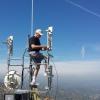Regardless of the outcome of the pending FCC NPRMs, we in the ham radio networking community need to try to take control of our future.
A bit of brainstorming here (caveat: I'm familar with RF design, but not at microwave):
10 GHz is the next band with enough bandwidth to accomplish the kind of throughput we need to continue to maintain and expand our network.
There is no clear path via commercial equipment to the ham 10 GHz allocation as far as I know. But there a number of 10 GHz transverter designs out there. Most of them have an I/F output of 144-146 MHz, but that could be switched to either 2 GHz or 5 GHz (fairly simply, I believe). The ones I looked at have relatively low power output (~ 10 dBm), but that's offsite by dish antenna gains of 34-38 dB.
A pair of them in line with the outputs of a Rocket M5 (could be M2), fed into a 10 GHz MIMO antenna could be a path to implementing network backbone bandwidth specific to amateur radio. A 3D printed housing to slip on top of a Rocket enclosure could house them. Power to the transverters could be provided by two Ethernet jacks mounted in the housing to loop POE in, then out to the hosting Rocket.
A quick googling shows there are a number of 10/11 GHz dishes out there, albeit not inexpensive. But for the small number of high-bandwidth links needed, it might not be too high a burden.
Comments?
Orv W6BI
A bit of brainstorming here (caveat: I'm familar with RF design, but not at microwave):
10 GHz is the next band with enough bandwidth to accomplish the kind of throughput we need to continue to maintain and expand our network.
There is no clear path via commercial equipment to the ham 10 GHz allocation as far as I know. But there a number of 10 GHz transverter designs out there. Most of them have an I/F output of 144-146 MHz, but that could be switched to either 2 GHz or 5 GHz (fairly simply, I believe). The ones I looked at have relatively low power output (~ 10 dBm), but that's offsite by dish antenna gains of 34-38 dB.
A pair of them in line with the outputs of a Rocket M5 (could be M2), fed into a 10 GHz MIMO antenna could be a path to implementing network backbone bandwidth specific to amateur radio. A 3D printed housing to slip on top of a Rocket enclosure could house them. Power to the transverters could be provided by two Ethernet jacks mounted in the housing to loop POE in, then out to the hosting Rocket.
A quick googling shows there are a number of 10/11 GHz dishes out there, albeit not inexpensive. But for the small number of high-bandwidth links needed, it might not be too high a burden.
Comments?
Orv W6BI


I too having been thinking of the possibility of using a transverter for 10 GHz but still have a whole lot to learn about what might be involved in modifying an existing design, not only to the correct band, but that would allow the wide bandwidth we'd need, Then there's no doubt the extra expense. But still, for those long backbone links it might be worth it. Maybe one of the smaller companies would step up and offer one, maybe even in kit form, if we can prove there's a market for it(?)
In the same yet different vein, I was imagining the possibility of squeezing another channel out of the 13 cm (2.4 GHz) band. With the present channel layout we only have one part 97 only channel, channel -2, centered at 2397 MHz, which we make abundant use of on our area system for “last mile” modes. I noticed the Ubiquiti firmware has a feature called “channel shifting” that can move the tuning up or down one or a few MHz, in between the standard WiFi channels, so the hardware is apparently capable of doing this. I'm wondering if there is something in the OpenWRT code that mimics channel shifting that could be used by AREDN devices. Specifically to define two 5 MHz channels, one centered at 2393, the other at 2398. That would still leave a guard band at the bottom, yet keep us a little further away from the WiFi traffic at the top. Just a thought!
Those would work, Ken, thanks. They fit in the 10 GHz ham band. Pricey, and discontinued in 2018 :(
Would still be nice to find something for that band that could run AREDN software though.
Orv W6BI
There are still a few in the pipeline, but in limited numbers.
One would hope ubnt would come up with a newer better version but I guess the market is not there.
In any case, this illustrates the problem with 10 GHz. It costs twice as much and goes half as far ....
Ken
Joe had brought up the MikroTik 60GHz devices and how they appear to be LHG, SXT, and RouterBoard 5GHz devices that have been redesigned to work at 60GHz. They are expensive and short range (same problem with the Ubiquiti 10GHz devices, but not as bad), but it's another option if a link is needed but all of your bands and channels have been exhausted. Joe mentioned we may be able to create AREDN firmware for them (possibly):
https://www.amazon.com/Mikrotik-Wireless-RBwAPG-60ad-wireless-duplex/dp/...
https://mikrotik.com/product/sxtsq_lite60
https://mikrotik.com/product/lhg_60g
-Damon K9CQB
Orv W6BI